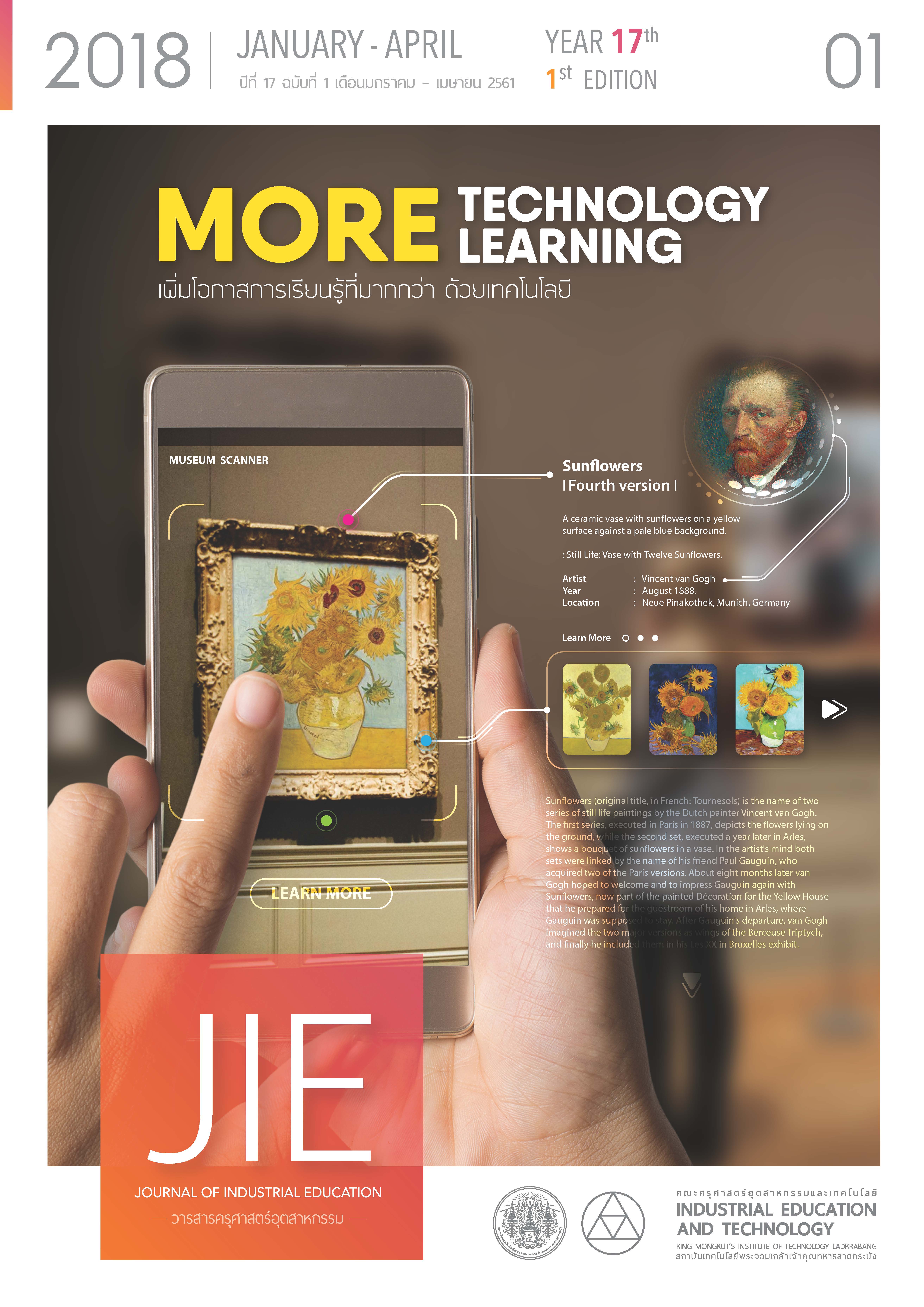รูปแบบสมการโครงสร้างของปัจจัยที่มีอิทธิพลต่อภาวะผู้นำเชิงวิสัยทัศน์ของผู้บริหารอาชีวศึกษา สังกัดสำนักงานคณะกรรมการการอาชีวศึกษา
คำสำคัญ:
รูปแบบสมการโครงสร้าง, ภาวะผู้นำเชิงวิสัยทัศน์, อาชีวศึกษา, ผู้บริหาร, ภาวะผู้นำบทคัดย่อ
การวิจัยครั้งนี้มีวัตถุประสงค์เพื่อ 1) ศึกษาปัจจัยเชิงสาเหตุที่เกี่ยวข้องกับภาวะผู้นำเชิงวิสัยทัศน์ 2) ตรวจสอบความสอดคล้องรูปแบบสมการโครงสร้างภาวะผู้นำเชิงวิสัยทัศน์ที่ผู้วิจัยพัฒนาขึ้นกับข้อมูลเชิงประจักษ์ และ 3) ศึกษาแนวทางการพัฒนาภาวะผู้นำเชิงวิสัยทัศน์ กลุ่มตัวอย่าง คือ สถานศึกษาอาชีวศึกษา จำนวน 446 แห่ง และผู้ทรงคุณวุฒิ จำนวน 6 คน เครื่องมือที่ใช้ ได้แก่ แบบสอบถามและแบบสัมภาษณ์ สถิติที่ใช้ในการวิเคราะห์ข้อมูล ได้แก่ สถิติบรรยาย การวิเคราะห์สมการเชิงโครงสร้าง และการวิเคราะห์เนื้อหา ผลการวิจัย พบว่า รูปแบบสมการโครงสร้างของปัจจัยที่มีอิทธิพลต่อภาวะผู้นำเชิงวิสัยทัศน์ของผู้บริหารอาชีวศึกษา มีความสอดคล้องกับข้อมูลเชิงประจักษ์ในเกณฑ์ดี รูปแบบสมการโครงสร้างภาวะผู้นำเชิงวิสัยทัศน์ ประกอบด้วย ปัจจัยความสามารถในการสื่อสาร การเป็นบุคคลแห่งการเรียนรู้ ความฉลาดทางอารมณ์ ความคิดสร้างสรรค์ และบรรยากาศและสภาพแวดล้อมในการทำงาน ซึ่งปัจจัยทั้งหมดสามารถอธิบายความแปรปรวนภาวะผู้นำเชิงวิสัยทัศน์ของผู้บริหารอาชีวศึกษาได้ร้อยละ 76 แนวทางการพัฒนาภาวะผู้นำเชิงวิสัยทัศน์ คือ 1) การพัฒนาตนเอง โดยการแสวงหาความรู้อยู่เสมอ และ 2) การพัฒนางาน โดยการนำวิธีการ ทฤษฎี หลักการไปประยุกต์ใช้กับสถานการณ์จริง
เอกสารอ้างอิง
[2] Narkwiboonwong, S. 2016. Vocational leadership. Bangkok: Kasetsart University.
[3] Kanhan. R. L. 2008. The social psychology of organizations. New York: Wiley.
[4] Sergiovanni, M. 1993. Leadership: System thinkers in action. London: Sage.
[5] Weisinger, B. 1998. The essentials of school leadership. London: Paul Chapman.
[6] Koys, G. 1991. Insiders and Outsiders: Women’s movement and organizational effectiveness. Canadian Review of Sociology and Antropology, 33(3), p. 391-410.
[7] Lunenburg, H. 1991. Handbook of leadership: A survey of theory. New York: The Free Press.
[8] Torance, I. 1962. Effective strategic leadership. London: Macmillan.
[9] Kanyankitti, P. 2014. Educational leaders. Journal of Education, 13(1), p. 44-52.
[10] Nanus, B. 1992. Visionary leadership. San Francisco: Jossey-Bass.
[11] Manning, W. and Robertson, R. 2002. Strategies for developing. New Jersey: Prentice-Hall.
[12] Kantabutra, F. and Avery, M. 2004. Educational leadership. New Jersey: Prentice – Hall.
[13] Groves, V. 2005. Lesson in strategic leadership for service. New York: McGraw.
[14] Thomas, G. 2005. Leadership behavior. New Jersey: Career Press.
[15] Wansi, C. 2007. Model of causal relationship of factors affecting the vision of school administrators. Basic Thesis. Educational Administration, Naresuan University.
[16] Lonlưa, N. 2012. Structural equation model of vision leadership of basic school administrators. Ph.D. thesis Educational Administration, KhonKaen University.
[17] Chuchom, O., Sukhan, A. and Chuawanli, W. 1999. Vocational education. Bangkok: Partnership.
[18] Ho̜mbuppa, S. 1999. Creative thinking with intelligence emotional intelligence the ability of primary 6 student. Master Thesis Educational Measurement, Naresuan University.
[19] Willium, L. 1994. Effective classroom management. Journal of Elementary School, 8(2), p. 219-231.
[20] Hay, W. and McBer, R. 2000. Managing effective organization: An introduction. Boston: Kent publishing company.
[21] Rogers, L. 1959. Taxonomy of educational objectives handbook. New York: David McKay Co Inc.
[22] Smith, K. and Hildreth, J. 1971. My personal journey toward professionalism. Young Children, 49(6), p. 69-71.
[23] Osborn, P. 1973. Principles of language learning and teaching. New York: Pearson Education.
[24] Litwin, B. and Stringer, H. 1968. Tolerance of ambiguity: A trait of the creative personality. Creativity Research Journal, 25(2), p. 232-237.
[25] Tanyatorn, R. 2010. Education and human resource. Journal of Education, 5(1), p. 103-117.
[26] Palasak, W. 2005. Education reform: an overhaul of the way of survival. 2rd ed. Bangkok: Sodsri-Saritwong Foundation.
[27] Steers, D. and Porter, B. 1979. Creating training miracles. Sydney: Prentice Hall.
[28] Sanrattana, W. and Phrưk, S. 2002. School administrators and organizational atmosphere. Journal of Education, 25(2), p. 17-28.
[29] Peter, S. 1990. A new look at management communication in management. San francisco: McGraw-Hill Book Company.
[30] Boonphak, K and Innoi, P. 2017. Learning management to Thailand 4.0: Active learning. Journal of Industrial Education, 16(1), p. 1-4.
ดาวน์โหลด
เผยแพร่แล้ว
รูปแบบการอ้างอิง
ฉบับ
ประเภทบทความ
สัญญาอนุญาต
"ข้อคิดเห็น เนื้อหา รวมทั้งการใช้ภาษาในบทความถือเป็นความรับผิดชอบของผู้เขียน"



